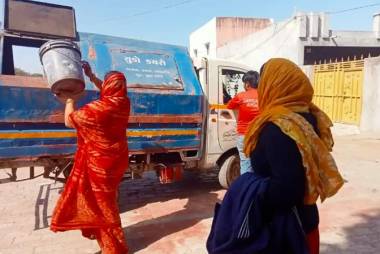Nayara Energy to create a waste value chain in Mithoi Village
Article Published On: 15 March 2023
 Nayara Energy Limited in partnership with the CSR Trust for SDG in India is implementing a plastic waste management project in Mithoi Village of Jamnagar District in Gujarat. The initiative aims to strengthen waste management practices and improve the overall health and hygiene of the village via investment in processes and behavioral change activities.
Nayara Energy Limited in partnership with the CSR Trust for SDG in India is implementing a plastic waste management project in Mithoi Village of Jamnagar District in Gujarat. The initiative aims to strengthen waste management practices and improve the overall health and hygiene of the village via investment in processes and behavioral change activities.
The interventions are a part of the Lighthouse initiative, undertaken in collaboration with the Department of Drinking Water and Sanitation (DDWS), Ministry of Jal Shakti and the India Sanitation Coalition at FICCI.
Located approximately 52 km from Lalpur Taluka headquarters, Mithoi village as per the 2011 census is home to 259 families and a population of 1395 persons from Darbar, Muslim, Koli, Satwara, and other communities.
A year ago, the waste management in the village, was in shambles as the community was accustomed to dumping 70 percent of its waste in the open, while the rest was used in cooking. Needless to say, open dumping led to an unclean and unhealthy environment as also the burning of plastic waste that produced harmful toxic gases.
Keen to address this, Nayara Energy Limited embarked on this socio-technical project which not only aims at improving the waste management scenario but also mainstreaming the waste workers into the waste value chain. The approach of the project is to initiate the said process, as well as create awareness by sensitising citizens through mohalla meetings, prerak samiti meetings, and multiple other awareness sessions, which also attempt to initiate behaviour change among the village communities across age groups.
The next step was to train waste workers – the safai sathis on promoting source segregation, segregated collection, resource recovery at the segregation shed, and selling the recyclables to recyclers, thereby creating a circular economy approach within the village.
Some of the key activities being carried out under this initiative are:
Door to Door waste collection system: The project has initiated door-to-door waste collection with coverage reaching 329 households and one school. The waste collected is sorted, and the recyclables are recovered and sold to recyclers from the segregation shed. The driver and the helper of the waste collection vehicle also inform the citizens about the importance of practicing source segregation and ensure that the households practice segregation of wet and dry waste at source.
IEC Activities (Information, Education and Communication): IEC activities carried out under the project aim to increase awareness, and change attitudes and behaviour towards waste management practices. This includes awareness activities in communities and schools.
Since community participation is indispensable to the success of the programme, they are actively involved via mohalla meetings emphasizing waste segregation (into biodegradable and non-biodegradable waste), and the harmful effects of disposing of inorganic waste on the roadside or near fields. Sessions are also carried out on the harmful impacts of Single Use Plastic (SUP), its ban, and the urgent need to switch to practical alternatives and reduce usage.
Furthermore, around 200 students have participated in various awareness activities conducted to raise awareness on the types of waste, segregation at source, health and hygiene practices, and other waste management initiatives, including the harmful effect of Single Use Plastic (SUP) and the importance of banning the same.
Village cleanliness and beautification: Under this initiative, various garbage vulnerable points have been identified and cleared through continuous community sensitization. The initiative also marked the participation of locally elected and appointed members as well as students. In addition, wall paintings were made in public spaces to reinforce the related messages.
